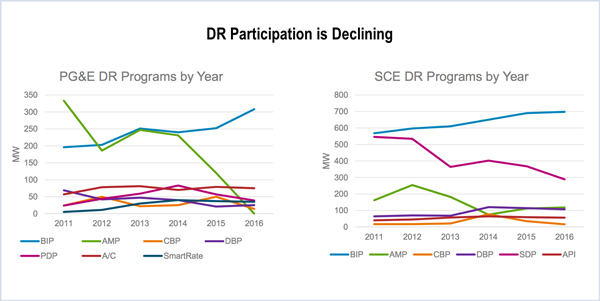By Jason Fordney
Frequent rule changes and an uncertain market structure are causing dissatisfaction among CAISO demand response providers and eroding participation in the programs, those providers say.
Problems with data verification and settlement required the ISO to recalculate its 2016 DR results, and providers say there are other issues with the program, which aggregates utility customers to facilitate their participation in the ISO’s wholesale markets.
“We have not received any energy payment of any dispatch of our resources going back to June 2016,” EnerNOC Director of Regulatory Affairs Mona Tierney-Lloyd told RTO Insider. While Tierney-Lloyd doesn’t think there are large payments still outstanding, “it is obviously sub-optimal,” she said.
EnerNOC and other companies aggregate retail electric customers and bid the load reductions into the CAISO market to offset the need for generation. Wholesale DR aggregates and compensates electricity users that reduce their consumption to below a pre-established baseline. Separately, utilities also maintain DR programs in which they provide customers a financial incentive to decrease load.
Tierney-Lloyd believes there are several factors causing the decline in DR program participation, including rule changes and modifications to the way DR resources are dispatched. There are also inconsistencies between CAISO and California Public Utilities Commission rules, she said. Agency misalignment is the primary cause of what she said is significant decline in DR program participation.
“It takes work on our side to get those customers familiar with those rule changes,” which also adds costs, she said.
During hot weather, it is more difficult for customers to reduce their usage below baseline, resulting in some taking efforts to reduce demand without getting paid. Others keep a close eye on CAISO operations and don’t understand why they are getting dispatches when no shortages are seen on the system.
CAISO uses DR as a way to make the grid more efficient and reduce greenhouse gases associated with climate change. While the ISO has a number of DR program improvements underway, its past problems slowed payments to market participants. (See CAISO Resettling 2016 Demand Response Results.)
In 2016, the DR system was sometimes unaware that an event had occurred, or the system did not deliver settlement data, CAISO said. The system was not receiving the correct “payload” to identify that a DR event occurred, so the system was unaware of the event and no performance measurement was completed. But even when the event day and historic meter data were available, the DR system in some cases did not send the values to the settlement system, so no settlement occurred. The ISO’s full resettlement should be completed in October.
The CAISO Board of Governors recently approved the second phase of a program meant to make distributed resource integration easier, dubbed the Energy Storage and Distributed Energy Resources (ESDER) Phase 2 proposal. (See New CAISO Rules Spell Increased DER Role.) ESDER includes a set of alternative energy usage baselines to assess the performance of proxy demand resources, one of a series of refinements to the DR program.




